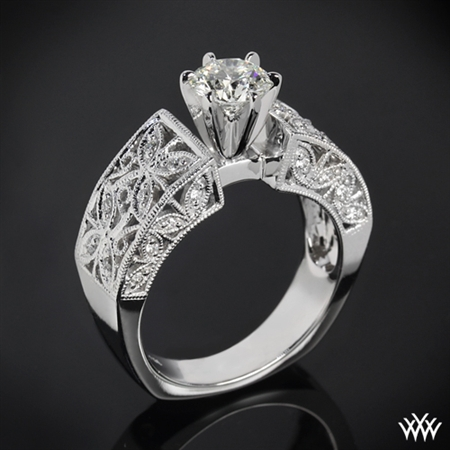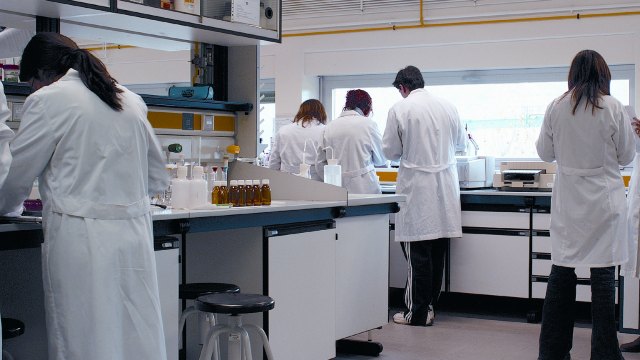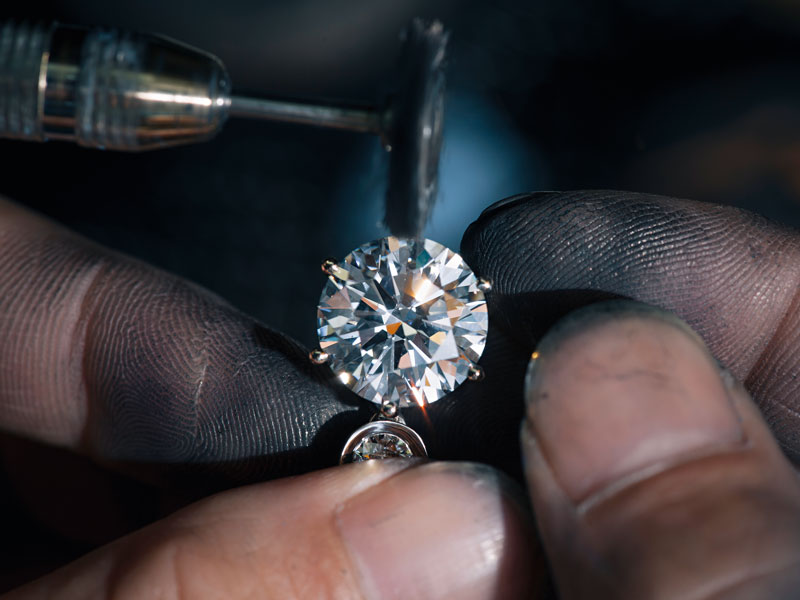
Moissanite vs. Diamond: Which is Better?
April 23, 2022
How to Buy Antique or Vintage Style Engagement Rings
June 19, 2022Should You Buy a Lab-Grown Diamond?

What are lab-grown diamonds? What are they worth? Are they real diamonds? These questions plague online comment boards and the minds of new diamond buyers constantly. Lab-grown diamonds are a point of contention, with some falling on either side of the for or against debate.
However, in reality, lab-grown diamonds are valuable, legitimate gemstones that can create incredibly impressive jewelry. So in the battle of natural vs. lab-grown diamonds, do they stand up to pressure?
- What Are Lab-Grown Diamonds?
- Are Lab Grown Diamonds Real?
- Are Lab-Grown Diamonds Certified?
- How Much Do Lab-Grown Diamonds Cost?
- Can You Tell the Difference Between a Lab-Grown Diamond and a Natural Diamond?
- Should You Buy a Lab-Grown Diamond?
What Are Lab-Grown Diamonds?
The clue is in the name—lab-grown diamonds are diamonds that are not naturally formed over millenia in the hot, tumultuous mantle of the earth. Also known as synthetic or artificial diamonds, these are diamonds crafted in labs, consisting of structures of pure carbon atoms. They have the same chemical makeup of natural diamonds and the same optical and visual characteristics.

This is an image of a lab-created diamond that was previously available from James Allen. It’s 2.71 carat and VS1 clarity, meaning it’s quite an impressive example of just how appealing lab-grown diamonds can be. Image credit: James Allen
How Are Lab-Grown Diamonds Made?
With modern technology we can recreate the processes of Mother Earth. In their natural form, diamonds are made when carbon is compressed under intense heat and pressure. Lab-grown diamonds are essentially formed the same way, but under controlled conditions that results in a diamond ready in weeks rather than in millions of years.
A lab-grown diamond begins with a ‘diamond seed’. This is a tiny fragment of diamond that acts as an anchor for pure carbon to be placed on. Then, like coral growing on the hull of a sunken ship, the carbon will alter under the environmental pressures created by machinery designed to mimic the conditions of the Earth.
There are actually two methods of synthetic diamond creation; High Pressure-High Temperature (HPHT), and Chemical Vapor Deposition (CVD). HPHT utilizes the diamond seed we mentioned, where intense heat (around 2,700 degrees Fahrenheit) and pressure (1.5 million pounds per square inch) alters the composition of the carbon.
In contrast, CVD introduces a mix of chemical gases that denature and then harden, forming crystallized carbon atoms.
Is a Lab-Grown Diamond the Same as a Cubic Zirconia?
Cubic zirconia and lab-grown diamonds are not the same thing. A lab-grown diamond is pure carbon, where atoms are arranged in a diamond cubic structure. Cubic zirconia, on the other hand, is the cubic crystalline form of zirconium dioxide, meaning it is chemically distinct from diamond.
Are Lab-Grown Diamonds Real?
While diamond purists tend to prefer natural diamonds, there is no difference in the chemical makeup of natural and lab-grown diamonds. The only real difference is how old they are, and where they originate from. So, lab-grown diamonds are completely real.
Are Lab-Grown Diamonds Certified?
As these types of diamonds are made under strict conditions in labs, they will naturally be the easiest to certify, as they’re essentially standardized products that are coming off the “assembly line”. They’re easier to trace the origins of too, and so many customers who are concerned with the ethics of their diamond purchases might be more interested in choosing a lab-grown diamond.
As is stands the best certification for lab-created diamonds is the IGI, because they give specific gradings for qualities like Color and Clarity. The GIA has recently started fully grading lab-created diamonds recently as well.
Where to Find Lab-Grown Diamonds
Whiteflash has leveraged over two decades of expertise in diamond light performance and precision diamond cutting to create a Precision Lab collection. This collection is perfect for those who want to beat the high price of natural diamonds while still achieving maximum fire and sparkle. The Precision Lab diamonds are cut to exacting standards to ensure that they show off their best light performance and brilliance. With the substantial savings found in lab diamonds, shoppers no longer have to sacrifice cut quality.

Shop Whiteflash Precision Cut Lab Diamonds
Brilliant Earth are one of our favorite diamond retailers, and they’re one of the best places for finding lab-grown diamonds. In fact, they have a whole section of their site dedicated to these synthetic diamonds.
Explore lab-grown diamonds from Brilliant Earth
Like Brilliant Earth, James Allen is one of our top picks when it comes to recommending a specialized diamond retailer. They have a long history of offering incredibly high-quality diamonds. They also have a wide variety of lab-grown diamonds available for you to peruse today.
Explore James Allen’s lab-grown diamonds
How Much Do Lab-Grown Diamonds Cost?
Lab-grown diamonds aren’t as expensive as natural diamonds, which is to be expected. Because they’re a made item, they’re not rare. Natural diamonds are, and the rarity naturally contributes a lot to the price. However, like natural diamonds, the price of lab-grown diamonds varies greatly.
That being said, because lab-grown diamonds are created under lab conditions, the main characteristic that will change their price is carat weight, as other characteristics, such as cut, clarity, and color, are less likely to change.
Are Lab-Grown Diamonds Good Investments?
This is a tricky question. In general, lab-grown diamonds do not have the resale value that natural diamonds do. Their prices have dropped dramatically in the last few years as more and more of them are created, which is good for those buyers working to a strict budget. As with other products, the less scarcity there is, the cheaper they are.
If we’re strictly talking monetary value (there’s obviously a lot of emotional value to any diamond bought for a loved one), then lab-grown diamonds will never be worthless. There are countless things that affect their price and value over time, so it’s very difficult to say what a lab-grown diamond bought today would be worth in five or ten years’ time. Traditionally, the value of diamonds rise, yet this is for natural diamonds—it’s probably not the case that this applies with their lab-grown counterparts.
In general, lab-grown diamonds are not the best investment in terms of monetary value. However, if you’re buying on to use in an engagement ring, that shouldn’t matter too much. The emotional value of the gemstone is also important to focus on.
You can also weigh up the relationship between value over time and initial value. A natural diamond will be very expensive at first, and depreciate in value by around 50% through ownership. While a lab-grown diamond will lose most of its original value, the initial cost will be far less expensive.
Can You Tell the Difference Between A Lab-Grown Diamond and a Natural Diamond?
You can’t tell the difference between a lab-grown diamond and a natural diamond, at least not with your naked eye. Professionals will use specialized equipment to tell the difference, but even then the similarities will be more apparent than any differences. The best way to tell the difference between a lab-grown diamond and a natural diamond is to look at the documentation.
Using specialized equipment, a gemologist might be able to spot differences in the inclusions in a lab-grown diamond. If they are present, they may appear more uniform and less ‘organic’ than those present in a natural diamond of the same clarity grading. Additionally, natural diamonds can sometimes reflect light differently to synthetic ones, yet being able to spot this with the naked eye is also incredibly rare.
Should You Buy a Lab-Grown Diamond?
A lab-grown diamond is a worthwhile buy for someone looking to save a significant amount of money. However, be ready for a much reduced going price if you’re ever to sell. This is probably the biggest downside to purchasing a lab-grown diamond, as in other respects, they’re just as good as natural ones.
However, price shouldn’t be the main reason you’re purchasing a specific diamond. Yes, natural diamonds won’t lose their value to the same extend lab-grown do, but they also have a much more compelling nature to them—they’re natural and rare, and simply much more interesting because of that.
Personally, I would not invest in lab-grown diamond if I knew they were to lose their value, whereas a natural, identical product wouldn’t. However, if that isn’t an issue for you, then lab-grown is a wise choice.
Where to Find Natural Diamonds


